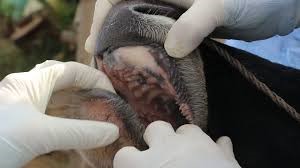
Foot-and-mouth disease (FMD)

19.03.2024
Foot-and-mouth disease (FMD)
|
For Prelims:About Foot-and-Mouth Disease (FMD),Important points, |
Why in the news?
According to recent reports, foot-and-mouth disease (FMD) has affected about 60% of milch cattle in Pilibhit district.
Important points:
- To control this disease, the Animal Husbandry Department has arranged for more than 3 lakh vaccines.
- According to official data, dairy owners and agricultural farmers own more than 3.5 lakh cows and buffaloes in Pilibhit district.
- According to veterinary scientists, the infection can spread to humans by consuming raw or pasteurized milk from infected cattle.
- Raw or pasteurized milk from infected cattle can also be a possible way of spreading the infection to humans, although it is not fatal.
About Foot-and-Mouth Disease (FMD):
- It is a highly contagious viral disease of livestock that has a significant economic impact.
- The disease affects cattle, pigs, sheep, goats and other two-hoofed ruminants.
- Intensively farmed animals are more susceptible to the disease than traditional breeds.
- It does not affect horses, dogs or cats.
- It is a transboundary animal disease (TAD), which profoundly affects livestock production.
- It also has nothing to do with hand, foot and mouth disease.
- It is a common childhood disease caused by a different virus.
- FMD causes fever and blister-like sores on the tongue and lips, in the mouth, on the udders and between the hooves.
- The disease is rarely fatal in adult animals, but mortality is often high in young animals.
- The disease causes severe production losses, and while most affected animals recover, the disease often leaves them weak and debilitated.
- It was the first disease for which the World Organization for Animal Health (WOAH, founded as OIE) established official status recognition.
Source: Times of India